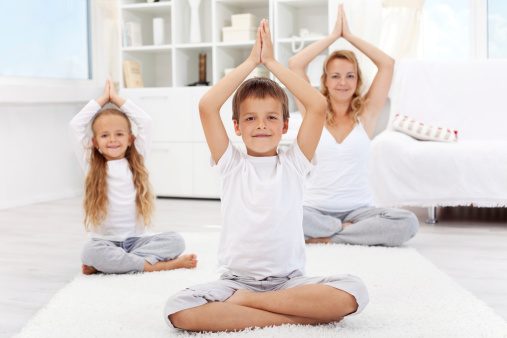Yoga boosts confidence in kids
It has given my tween-aged daughters a confidence boost

Source: Best Health magazine, October 2014
My nine-year-old, Charlotte, and her friend Eleni are rolling on the floor next to me, laughing. My other daughter, Lauren, 11, had been teaching them a yoga exercise in which they start in a crouch, then straighten their legs while keeping their hands on the floor.
‘It feels ridiculous!’ says Charlotte, disguising her voice to be deep and throaty, like a frog. Lauren rolls her eyes and asks Charlotte and Eleni to sit cross-legged again in lotus position. ‘Okay,’ she says. ‘All of us, except one person, are going to get into downward dog pose. The one not in the pose is going to crawl underneath the others. When she does, each of us is going to say something we like about that person.’
Charlotte is the first to crawl underneath. I tell her, ‘I love how cuddly you are.’
‘I love that you are my little sister,’ says Lauren.
‘I love that you never say you don’t like me,’ says Eleni.
I started doing yoga with my daughters about six years ago for a number of reasons. Foremost were the studies praising its benefits. Researchers at Leipzig University in Germany showed that children who did yoga regularly were calmer, less impulsive and aggressive, and better able to deal with stressors. Another report, published in Pediatric Physical Therapy, examined the literature and concluded yoga has physiological benefits for children. In fact, yoga for kids has become so popular it is available at many schools in North America.
It’s important to me that my girls have a healthy body image; I had food-related issues as a teen. A 2008 Canadian study found that 37 percent of girls in Grade 9, and 40 percent in Grade 10, believed they were too fat’many believed this even though their weight was normal. The U.S.-based National Association of Anorexia Nervosa and Associated Disorders says 95 percent of those with eating disorders are between ages 12 and 25.
I’m convinced it’s partly thanks to yoga that Lauren, who is at that awkward age when her shape is changing, is comfortable with her body. Both she and Charlotte like what they hear during the sessions: that having strong, confident bodies can help them achieve their goals.
I also like the time my daughters and I spend together doing yoga. And one other priority for me was introducing it as a strategy they could use in the long term to help them still their minds. While the parent-child classes at our local studio were great for my kids when they were young’the poses being animals and stars’when they hit tween age, they became uninterested. The adult yoga classes also turned them off. ‘I have no idea what is going on,’ Lauren said after I took her to an introductory hatha yoga class.
I needed something tailored just for them, and I found it with Aruna Kathy Humphrys, a kundalini yoga teacher who designs programs through her company, Toronto-based Young Yoga Masters. Humphrys incorporates yoga philosophy through wonderfully told stories such as from the popular book Zen Shorts; meditations; and, of course, yoga poses. She helps tweens become mindful of their thoughts. And most of all, Humphrys encourages kids to ask questions. Almost always, my girls’ questions have to do with bullying, grades, their appearance, their friends. Not once have they asked yoga-related questions.
Professor George Scarlett, deputy chair of the Eliot-Pearson department of child study and human development at Tufts University, divides the tween age group into two. Kids aged about nine to 11 are into achievement and measuring their self-worth against others’, he says, whereas those 11 to 14 are becoming conscious of having an interior life they feel is hidden, and that is different from how they present to others. This, says Scarlett, creates a kind of loneliness, and a fear to share their interior life with others, making intimacy a challenge. ‘Authority figures should support their friendships, be patient and give them approval for just being themselves.’ Adds Boston-area yoga teacher Susanna Barry, senior program manager in the community wellness program at MIT Medical health centre, giving tweens a chance to create poses helps them develop their leadership skills.
My daughters and I begin our sessions with breathing. Charlotte describes what that means to her as a nine-year-old: ‘I breathe in the thoughts of what I can do and who I am, and breathe out the words of kids who told me mean things and made me feel little.’




